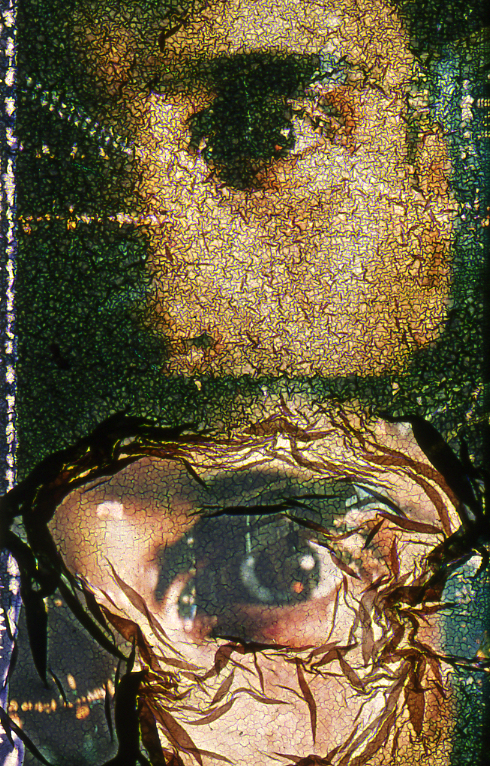The Aesthetic WOW!
By Richard Kerr

Excerpt from Demi-Monde / Richard Kerr
As life long practitioner and educator of an Avant-Garde cinema, I have been asked to reflect on the future of cinema. As an educator, I am working with a generation of students whose central concerns and questions are “What is cinema?” or the more heated debate, “What is not cinema, or what is cinema’s future?” In fact, what they are asking is “How am I going to navigate and find my place in the future?” The questions of cinema’s future, I would suggest, are more tedious than complex.
To survive as a practitioner in the today/tomorrow world of techno-based cinema, one needs clarity of purpose; confusion leads to loss of time and a softening of ideas and resolve. I am blessed with an absolute clarity of what cinema is, and therefore, I do not panic: it is an individual cinema. All the rest, meaning meta-cinemas in all incarnations, are a joyous ride– a journey through the amusement park-like evolution of what is being presented as a cinema of today/tomorrow.
(My) cinema, the individual’s cinema, was sharply focused on the American Avant-Garde (circa 60s/70s): a well critiqued (admittedly limiting and elite) genre of cinema. Nonetheless, it was a glorious time to be young, naïve, and curious about a cinema that was defiant but rigorous (and ambitious about its commitment to “their” cinema’s place in the larger dialogues of art).
That cinema, which became (my) cinema, opened a path for individuality, questioning, and self-cultivation. Personally, (my) cinema was about the pursuit of the Aesthetic WOW!: the experience of those life-affirming screening/projections that shaped your muse and your relationship to your future in cinema. Learning from the battleground of the Avant-Garde tends to galvanize one’s ideas about what cinema can and cannot be.
(My) cinema in reduction and purity is light, time, and space: rhythm, or the shaping of time through projected light. Medium specificity, form, structure, and poetics are what I respond to in any and all cinemas. For sanity’s sake, I must have clarity and resolve in preparation for what the future of cinema will ask. The anxious questioning of cinema’s future intensified with the accelerated arrival of digital technology. Only through a daily practice of engagement with digital technology did it become apparent that this all was new: new aesthetics, new values. I would be well advised to be clear about what was learned and true about (my) cinema, but I should be prepared to leave the “old school” and return to the “new school”... FOREVER! (A Tom Sherman idea, my lesson.)
As a practitioner, I approach questions about cinema’s future through intuitive daily practice and play with the “new” materials, hybrids, and technologies. It remains true in practice; the feeling finds the form. There is not a lot of pressure about the future when one is obsessed and preoccupied with the work before them.
As an educator, this is where the provocation begins. As I stand back and observe these mythic complexities about cinema’s future, I am compelled to provide an optimism and enthusiasm for the next generation of practitioners (with some reserve: not about the direction of cinema itself but the maker’s future). With the right attitude, an understanding of history, and a clear resolve, the cinema practice of the future looks exciting with unlimited potential. Gear up! And get makin’… Cinema has always been driven by technology and the practitioner has always led the way. The unknown issues of cinema’s future are not in the technology and access, but instead in the values digital technology asks and offers. With the digital revolution comes a “new” democracy of making. This new democracy comes with a critical and cultural fragmentation.
Democracy and fragmentation have blown open the playing field: everyone can be an artist, all voices are legitimate, the critic has gone home, the canon of the past is secure, and the practitioner can freely play and be risqué (but not risky). Though the pressure to be popular is on, the pressure for “test of time” quality has eased. In digital cinema practice, there is no boss and no censor; we are close to the Godardian dream of free authorship. Freedom of creation is not the issue. The real issue is: what will the practitioner do with all this techno-induced democracy and freedom of production? Will the future cinema drown itself in its own noise? Will the system trick us into an empty revolution? My concern is ultimately not for the future of cinema per se. My concern is about the future of the individual who produces the future cinema. Know and believe in your individual cinema, and feel blessed for having a cinema you believe in.
This article was first published in French translation in 24 images: Revue québécoise du cinema, no. 129 (2006).
ABOUT THE AUTHOR
Richard Kerr is a practitioner/teacher who works out of the Mel Hoppenheim School of Cinema in Montreal. In Fall of 2008, he will be Professor of Distinction at Ryerson University, School of Image Arts, in Toronto.
INCITE Journal of Experimental Media
Manifest
